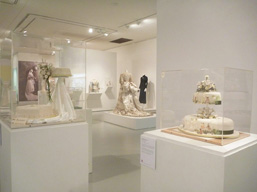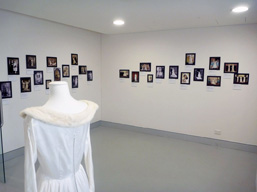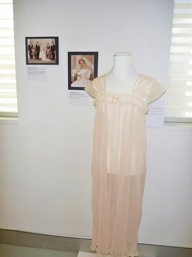Here Comes the Bride
10 February – 26 March 2017
Following on from the success of our fashion and social history exhibition of 60's clothing Swinging, this exhibition celebrates the bride and her gowns through a the stunning display of bridal dresses, outfits and accessories from the celebrated Darnell collection. The Darnell Collection is considered the largest private vintage clothing collection in Australia. The collection holds a mirror to our time, and tells the story women's wardrobe since 1720 to present day. It includes over 10000 pieces from 32 different countries. Many internationally recognised 20th century designers are represented. The collection was gifted to Charlotte Smith by her godmother Doris Darnell, a Quaker from Pennsylvania and passionate collector of fashion and vintage clothing in 2004. For the past 14 years Charlotte has researched (and is currently cataloguing) the collection. Aside from the importance of construction, design and the diversity of fabrics, social history and the history of fashion are important aspects of the collection.
The exhibition also includes dresses and accessories from the collection of Hawkesbury regional Museum and historic wedding photography and portraits - Love is in the air!
Each dress has a story - sometimes two - to tell!
It’s meant to be the happiest day of a couple’s life. And while not all weddings might end up leading to a life of joy, the sheer numbers of wedding dresses that are preserved by their owners are testament to the importance of the celebration – and perhaps sometimes the cost of the dress.
Wedding dresses can record the history of a district; the wealth or ingenuity of their owners as well as providing an important record of changing fashions.
Although wedding dresses kept in collections such as The Darnell Collection are only a small sample of the hundreds of thousands of wedding dresses worn each year, it is fascinating to take a closer look at this very popular and widespread custom. We were fascinated in the changing symbolism of weddings and dresses as well as the other objects that make up a wedding and were prompted to examine in particular wedding dress colours and the way they have been understood.
Unlike every day wear which is frequently discarded, a bride’s dress is usually cherished and preserved. Weddings are vested with such social importance that information about wedding dresses, such as the wearer and the date they were made or worn, is often known and this can make them particularly interesting.
The Darnell collection contains many white or cream wedding gowns from the late nineteenth century and early twentieth century. However, Western wedding dresses have not always been white. Roman brides wore yellow. During the Middle Ages blue was considered the colour of purity, not white, and both bride and groom wore a band of blue. In the sixteenth and seventeenth centuries pale green was a popular colour for wedding dresses, due to its association with fertility.
The tradition of the white wedding dress only originated in the nineteenth century. Although brides continued to wed in other colours, Queen Victoria’s white wedding gown in 1840, set a lasting trend in wedding fashion. White, symbolising purity and chastity, became the favoured colour. Interestingly, in the nineteen century many ‘white’ wedding dresses were actually cream as bleaching silk to a crisp white only became possible in the twentieth century with the use of harsh chemicals.
Prior to and well into the nineteenth century, there was no single colour that was customary for wedding dresses. Brides generally wore their best dress, whatever its colour. Bridal fashions were very similar to contemporary mainstream fashion, making it easy for brides to reuse their wedding dress for smart occasions or as every day wear, with minimal alterations.
In the Darnell Collection there are examples of non-white wedding dresses which were reused, most likely reincarnated as ‘best dresses’.
Before modern medicine, a long and healthy life was not easy to achieve, but people tried to ensure good luck by following superstition. Many superstitions grew up around weddings, to bring about a girl's happiness in her new home and, of course, to guarantee her fertility. The colour of the gown was a popular source of luck.
There were popular colours like pink, considered most suitable for a May wedding. It was flattering to most complexions and associated with girlhood.
Blue, with its associations with the Virgin Mary, was a strong symbol of purity as well as a traditional symbol of fidelity and eternal love. A bride’s who wore blue believed her husband would always be true to her. Even if her gown itself was not blue, she would be sure to wear something blue about her person.
This is tradition that has survived to this day. And why sapphire engagement rings are popular.
Green on the other hand was unpopular. It was considered the fairies colour. It was also linked with the lushness of verdant foliage and superstition had it that wearing green was sure to make it rain and spoil the day.
But the one colour that really would turn most brides off was brown, or any shades in beige. It was considered rustic. As the saying went, "Marry in brown you will live out of town."
More recently, Tina Turner married in iridescent green and black wedding dress, putting her own choice above superstition.
In Here comes the bride there are wedding dresses from the Nineteenth Century right up to present day. Some of the dresses are expensive bespoke labels, ordered from interstate or even overseas. Others are locally made – and a great many are handmade, most often by a bride’s mother. The difference between an expensive store bought dress and a handmade one is often hard to discern, the quality of the sewing being exceptional.
Around the time of the Great Depression, women were encouraged to make their own wedding dresses using cheaper materials such as crepe. They often dyed their dresses with coffee or tea afterwards to make ball gowns or formal wear.
In the 1950s the glamour of Hollywood was sought by women in the style of their dresses, with long trains and lustrous materials.
During the twentieth century wedding fashions diversified. While wedding dresses often mirrored contemporary fashion, it also became acceptable for wedding dresses to resemble older styles, which made it less likely that a wedding dress would be worn again. Today most brides wed in white or cream and rarely wear their wedding dresses after their wedding.
Looking at the wedding dresses there is something lovely about a stylish but practical dress, not only worn once for a marriage ceremony, but also worn years into the marriage and altered according to fashion and the woman’s changing life.
Here comes the Bride also included large scale photographs of original wedding portraits of brides in their dresses both from the Darnell Collection and also photographs from brides who married in the Hawkesbury.
Alongside the dresses from the Darnell Collection was a small display of bridal and wedding attire donated to the Hawkesbury Regional Museum by Joan Hagerty-Peak. The donation included wedding dresses, going away and trousseau items from three generations of women descended from William Cox. This donation was shown against a stunning backdrop of contemporary wedding photographs sourced from the Hawkesbury community.
Here Comes the Bride is a Hawkesbury Regional Gallery exhibition.
Page ID: 97564



